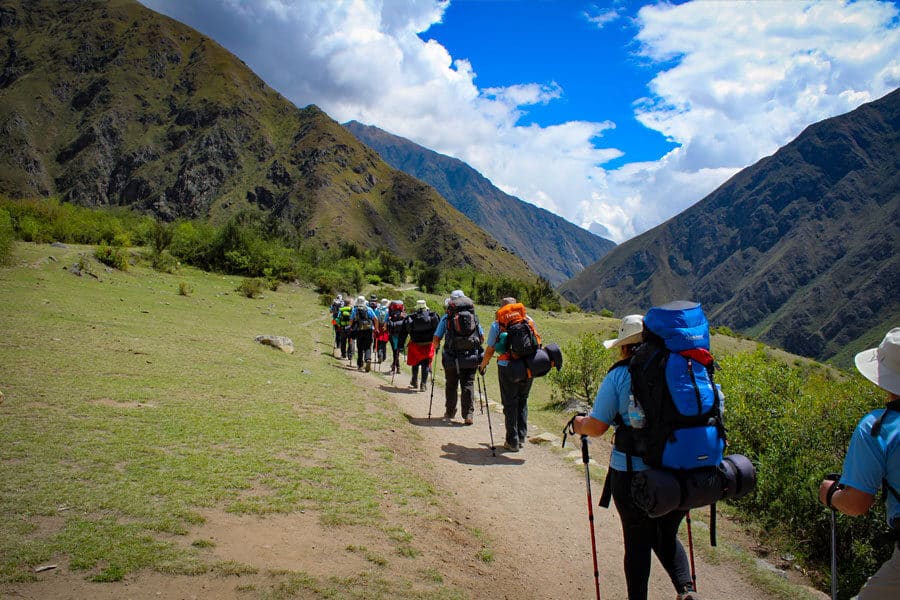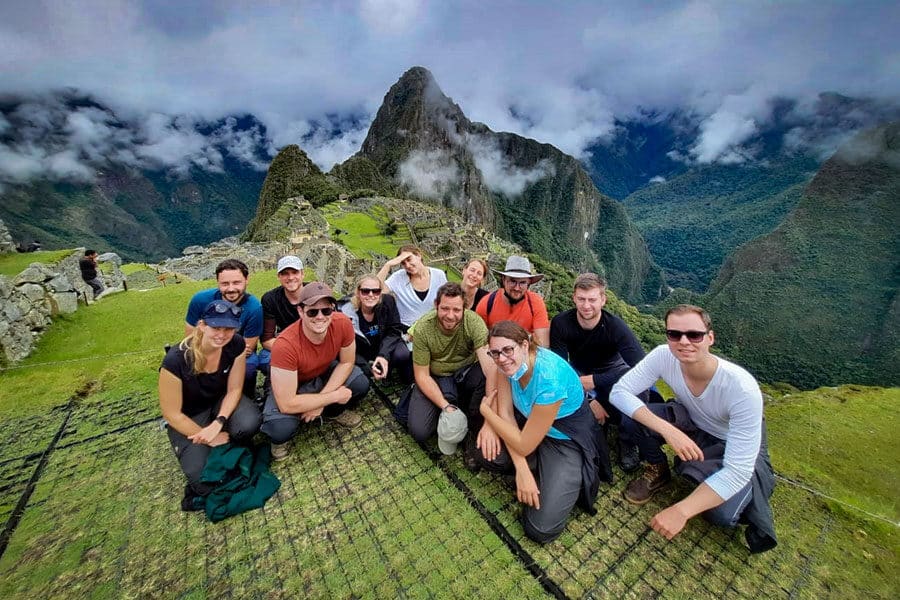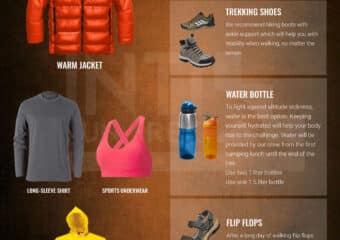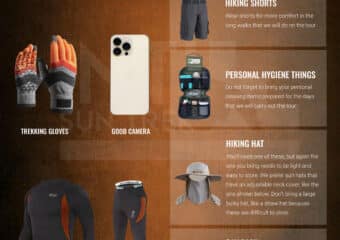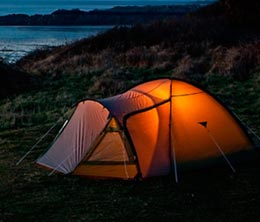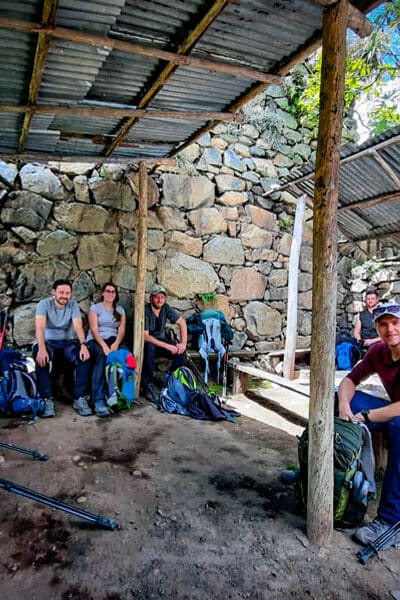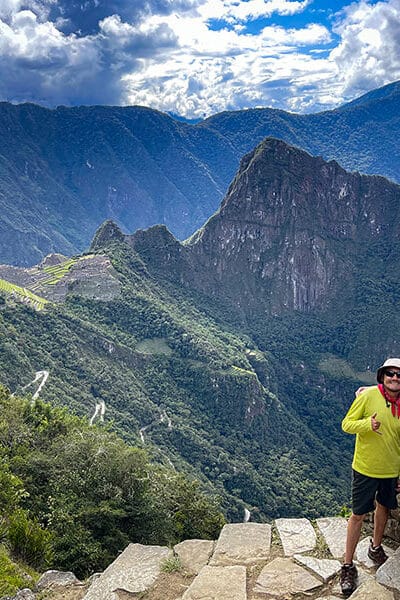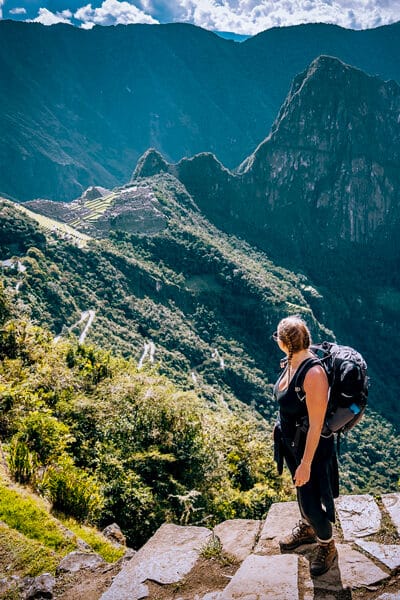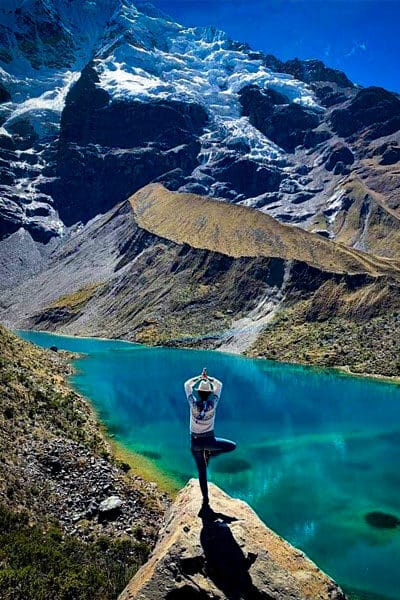Classic Inca Trail, Machu Picchu Hike 4D – Our standard four-day group trek is the most popular of the Inca Trail treks that we offer. On this trek, you will need to carry your sleeping bag and sleeping mattress. Together, the sleeping bag and mattress weigh about 2.5 kilos (4 pounds); most trekkers end up carrying about 7-10 kilos (14-20 pounds) total. (Porters will carry all food, cooking, and camping supplies.)
Worried it might be too much weight? Check out our Classic Inca Trail Trek to Machu Picchu with Personal Porter!
Peru
Classic Inca Trail
to Machu Picchu 4D / 3N
Summary
New Regulations
- The Inca Trail campsites mentioned in our itineraries may not always be the same at the beginning of your journey, as the campsites along the Inca Trail are subject to space availability, and it is the government authorities who grant us the spaces 2 days before the start of your tour. We cannot guarantee the Wiñay Wayna campsite on the third night for all our groups. As a result, some of our groups may have to camp at Phuyupatamarca on the third night of the trek.
- The Phuyupatamarca campsite is approximately four hours from Intipunku (Sun Gate). Despite these changes, we want to assure you that our clients will still have enough time to reach Intipunku and witness the beautiful sunrise.
- The new regulations of the Peruvian government regarding the Inca Trail indicate that the guided tour in Machu Picchu after your arrival at the Inca citadel will follow circuit number 3. Therefore, we recommend that you make the most of the opportunity to take all your photographs once you begin the descent from the Sun Gate and reach the viewpoint, where they will take the classic photograph of the entire Inca citadel. See the article about the Inca Trail and its new circuit to visit Machu Picchu.
Please note; that there will be trekkers of different abilities and differnet lenguaje in your Inca Trail group.. Our guides are very experienced and will work to accommodate the needs of all of our trekkers in a safe and friendly manner. However, if you and your friends or family all have the same fitness level and you would prefer to hike in a private group, contact us today about booking a private service for your Inca Trail adventure!
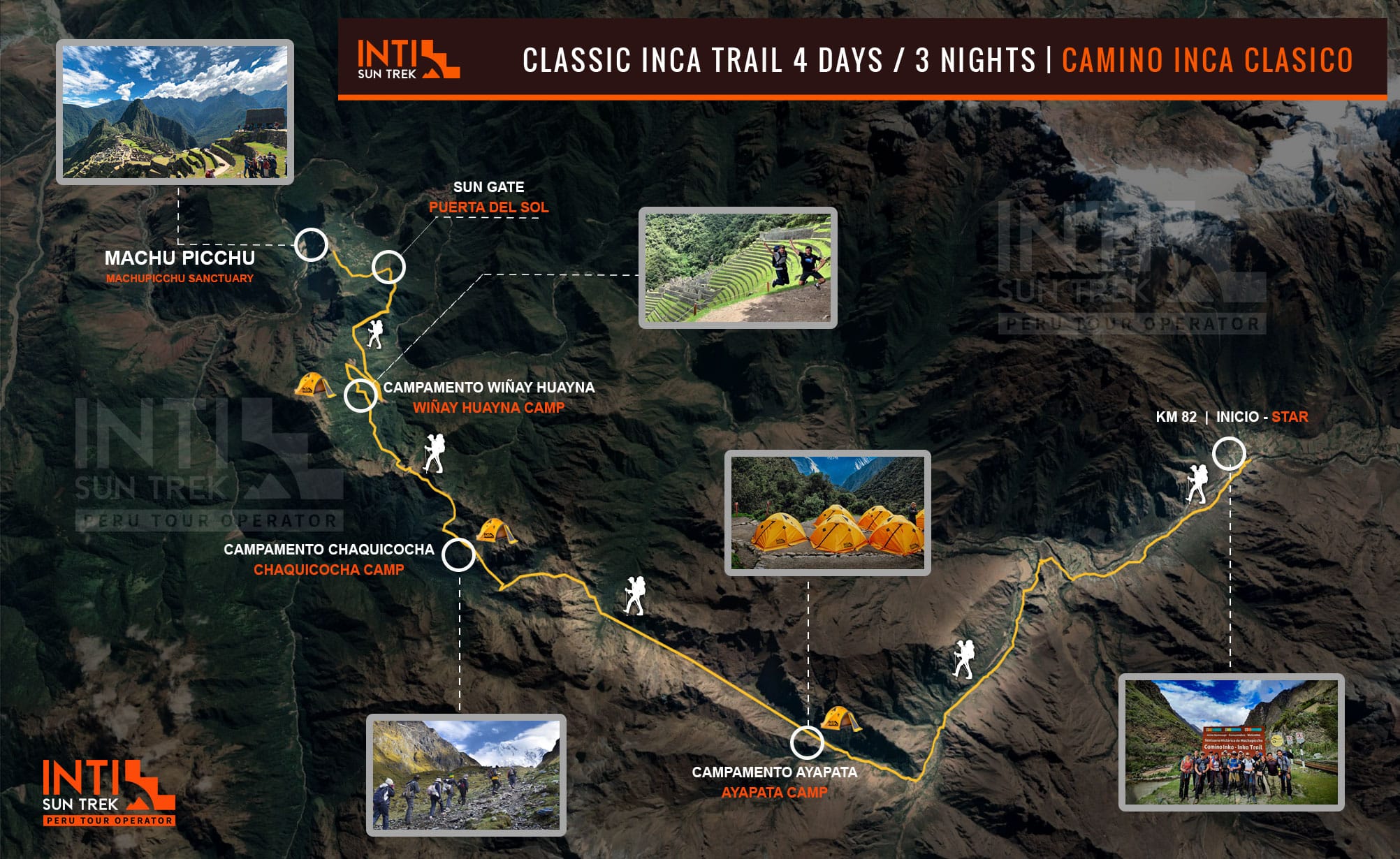
Overview Classic Inca Trail to Machu Picchu 4D
Day 1:
Cusco (3,300m) – Km82 (2550m/8269ft) – Yuncachimpa (3000m/9842ft)
The first day of the hike is fairly easy and serves as a warm-up for the days to follow. Our hikers are picked up early from their accommodation (5:30 a.m. – 6:00 a.m.), and travel by bus through the pretty villages of Chinchero, Urubamba, and Ollantaytambo
- Walking Distance: 12km / 7.45 miles
- Starting Elevation: 2720 m. / 8923 ft.
- Highest Elevation: 3000 m. / 9842 ft.
- Campsite Elevation: 3000 m. / 9842 ft.
- Difficulty: Moderate
- Weather: Warm to cold
- Inca sites to see / visit: Yuncachimpa & Llactapata
Day 2:
Yuncachimpa (3000m/9842ft) – Dead Woman’s Pass (4200m/13779ft) – Pacaymayu – Chaquicocha
The second day is the most challenging day of the trek: we will go over two high passes, walking about four hours uphill. In the morning, we will pass by Llullucha Pampa, the last place along the trail where it is possible to buy snacks and drinks.
- Walking Distance: 11km / 6.83 miles
- Starting Elevation: 3000 m. / 9842 ft.
- Highest Elevation: 4200 m. / 13779 ft.
- Campsite Elevation: 3580 m. / 11700 ft.
- Difficulty: Challenging
- Weather: cold
- Inca sites to see/visit: Runkuraccay & Sayacmarca
Day 3:
Chaquicocha – Wiñay Wayna or Phuyupatamarca
On this day, we will walk for only five hours, but see three Inca sites along the way. Though this is the easiest day, most hikers say it is the most unforgettable! From Chaquicocha, we will walk for about an hour and a half to get to Phuyupatamarca, the third pass, at an elevation of 3550m/11550ft.
- Walking Distance: 16km / 9.94 miles
- Starting Elevation: 3580 m. / 11700 ft.
- Highest Elevation: 4000 m. / 13123 ft.
- Campsite Elevation: 2680 m. / 8792 ft.
- Difficulty: Formidable
- Weather: cold
- Inca sites to see/visit: Phuyupatarmarca, Intipata & Wiñay Wayna
Day 4:
The Glory of Machu Picchu!
On our final day, we will wake up between 3:00 and 3:30 am in the morning, pack our bags, and set out for our final day of trekking to Peru’s most iconic landmark! Since our porters will leave us after Wiñay Wayna to descend by a different trail to the train station
- Walking Distance: 5km / 3.10 miles
- Starting Elevation: 2680 m. / 8792 ft.
- Highest Elevation: 2730 m. / 8956 ft.
- Machupicchu elevation: 2400meters/7873ft
- Difficulty: Easy
- Weather: warm
Itinerary
Day 1 – Cusco (3,300m) – Km82 (2550m/8269ft) – Yuncachimpa (3000m/9842ft)
Highlight of the day: Explore archaeological sites and take in the stunning Andean landscapes.
The first day of the hike is fairly easy and serves as a warm-up for the days to follow. Our hikers are picked up early from their accommodation (5:30 a.m. – 6:00 a.m.), and travel by bus through the pretty villages of Chinchero, Urubamba, and Ollantaytambo. The scenic trip lasts for two and a half hours before we arrive at Kilometre 82, the start of the trail, located at 2550m/8269ft. Our buses normally stop at the town of Ollantaytambo in the Sacred Valley for about an hour to give passengers the opportunity to have breakfast.
At Km 82, our hikers cross the Vilcanota River and embark on this unforgettable journey. You will be amazed by the great views of the Cordillera Oriental and the snow-capped peak of Veronica. We will start our trek not far from where Hiram Bingham began his re-discovery of the Inca Trail in 1915. From there, the trail is flat for almost two hours of hiking until we arrive at our first Inca site, Llactapata. On our way, we will pass a rest stop at Mescay, where there are bathroom facilities. The path then follows the left bank of the Cusichaca River to the small village of Wayllabamba, located at 3000m/9900ft, that serves as the porters´ checkpoint.
Continuing on, we will walk for one more hour until we reach the Tres Piedras, or Ayapata, which is going to be our first camp of the trek. Please note that with this itinerary, we may want to walk one more hour in order to walk for less time on the second day.
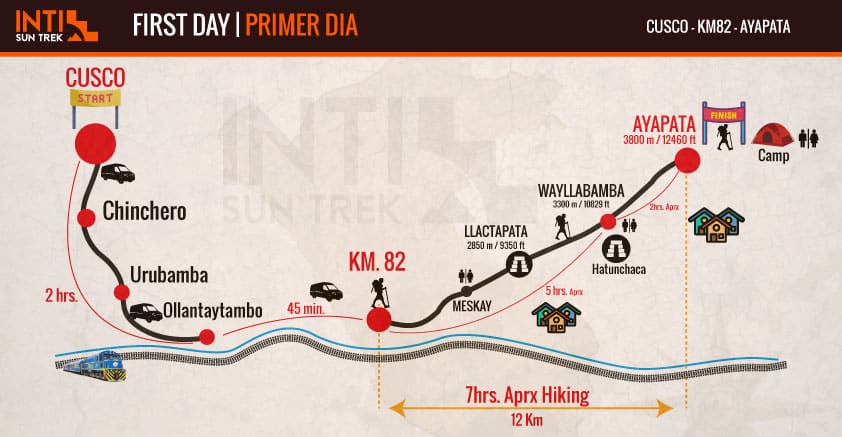
Day 2 – Yuncachimpa (3000m/9842ft) – Dead Woman’s Pass (4200m/13779ft) – Pacaymayu – Chaquicocha
Highlight of the day: Reaching the highest point of the trek at Dead Woman’s Pass and appreciating the view all around you.
The second day is the most challenging day of the trek: we will go over two high passes, walking about four hours uphill. In the morning, we will pass by Llullucha Pampa, the last place along the trail where it is possible to buy snacks and drinks. We will then continue hiking uphill for two hours until we arrive at the top of Dead Woman’s Pass, located at 4200m/13779ft.
This is the highest point of the Inca Trail. Once at the top, hikers can celebrate having completed the most difficult section of the trail, while taking stunning pictures of the scenery. We will then start to walk down for one and a half hour until we reach Pacaymayo, at 3600m/11880ft, where we will have lunch and have the possibility to use bathroom facilities. After lunch, we will continue hiking uphill for two hours until we reach the Runcuracay pass, at 3900m/12900ft, which is the second highest point of the Inca Trail. On the way, we will also pass the Inca sites of Runcuracay and Sacyacmarca, which means “Inaccessible Town”. The ruins at Sacyacmarca are protected on three sides by sheer cliffs. From this point, the path descends into a magnificent cloud-forest full of orchids, hanging mosses, tree ferns, and flowers. We will walk for two hours through this striking scenery until we reach our second campsite, Chaquichocha.
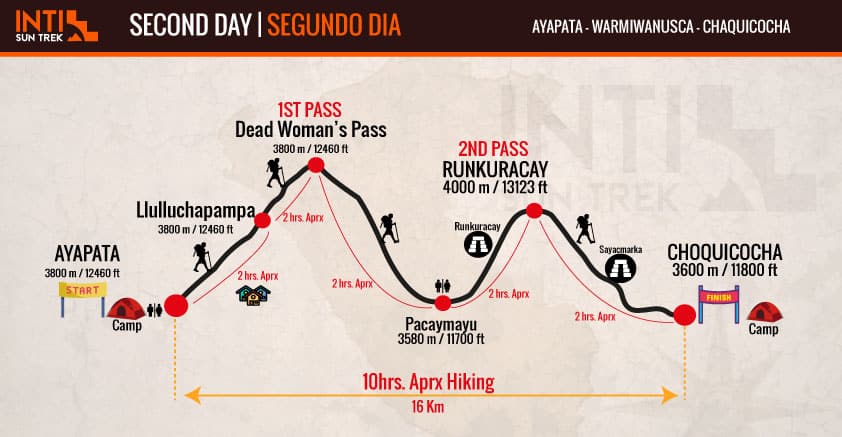
Day 3 – Chaquicocha – Wiñay Wayna or Phuyupatamarca
Highlight of the day: Phuyupatarmarca, Intipata & Wiñay Wayna
On this day, we will walk for only five hours, but see three Inca sites along the way. Though this is the easiest day, most hikers say it is the most unforgettable! From Chaquicocha, we will walk for about an hour and a half to get to Phuyupatamarca, the third pass, at an elevation of 3550m/11550ft. On the way, we will pass through an impressive Inca tunnel carved through sheer rock. From here, there are spectacular views of several snow-capped peaks, including Machu Picchu Mountain and the town of Aguas Calientes.
The Inca site Phuyupatamarca is located a short walk from the third pass. After visiting the site, we will continue to our final campsite, at either the nearby Phuyupatamarca campground or down a path of two thousand original Inca stone steps to Wiñay Wayna, located at 2750m/8910ft. (Campsites are assigned by the government three days before the trek and based on group size. For this reason, we cannot guarantee which camp you will stay at until your pre-trek briefing.) Wiñay Wayna is carved deep into the hillside above the Urubamba River and means “forever young” in Quechua. At whichever campsite we have the fortune to stay at, we will thank our porters for their tremendous efforts at the tipping ceremony, as in the morning they will descend downhill while we continue on to our final goal.

Day 4 – The Glory of Machu Picchu!
Highlight of the day: Exploring the amazing Machu Picchu and learning all of its secrets.
On our final day, we will wake up between 3:00 and 3:30 am in the morning, pack our bags, and set out for our final day of trekking to Peru’s most iconic landmark! Since our porters will leave us after Wiñay Wayna to descend by a different trail to the train station, we will take our breakfast to go. After a ten-minute walk, we will arrive at the Inca Trail’s final checkpoint, where we will queue with all of the other trekkers to wait for the park rangers to open the last section of the trail at 5:30 am. Our early wake-up time will ensure both that we get a forward spot in the line at the checkpoint and that our porters are able to catch the 5:30 am train.
Once the trail opens, we will hike in the early morning darkness for approximately ninety minutes until we arrive at Inti Punku, the “Sun Gate” (2730m/8792ft), just as the sun’s first rays appear over the rooftops at Machu Picchu—this first dramatic view of the sunrise over Machu Picchu will make for a memory you will never forget!
After soaking in the view, we will walk down the final part of the trail and approach the ancient city, where we will be able to celebrate our accomplishment and pose for photos together before the steep peaks and mist-filled ruins of this amazing place!
We will descend to the main entrance, where we can leave our backpacks, use the restroom, and enjoy a quick coffee. After our break, we will re-enter Machu Picchu for a walking tour of the mysterious city, According to the new Inca Trail regulations, we will re-enter Machu Picchu using circuit number 3
Once inside the Inca citadel, you will enjoy a guided tour of approximately two hours, exploring the most relevant sectors of this incredible ancient site. You’ll see houses, temples, terraces, and crop fields, among other features. The ingenuity of the Incas in terms of engineering work, which was far ahead of its time, remains a mystery in many aspects.
After your tour, you can choose to ascend Huayna Picchu Mountain (2,720 m / 8,924 ft) or Machu Picchu Mountain (3,000 m / 9,843 ft) These tours will take you approximately one and a half and three hours, respectively, for both ascent and descent (tickets must be booked in advance).
Ensure you return to Aguas Calientes for lunch before boarding your train to Ollantaytambo, which departs at around 18:20 (subject to availability). Our private transportation will collect you from the next station and drive you back to your hotel in Cusco at around 10 pm. Now you can put your feet up and enjoy some much-needed rest, but your heart will continue to beat to the rhythm of the Andes for many weeks, months, and years to come!
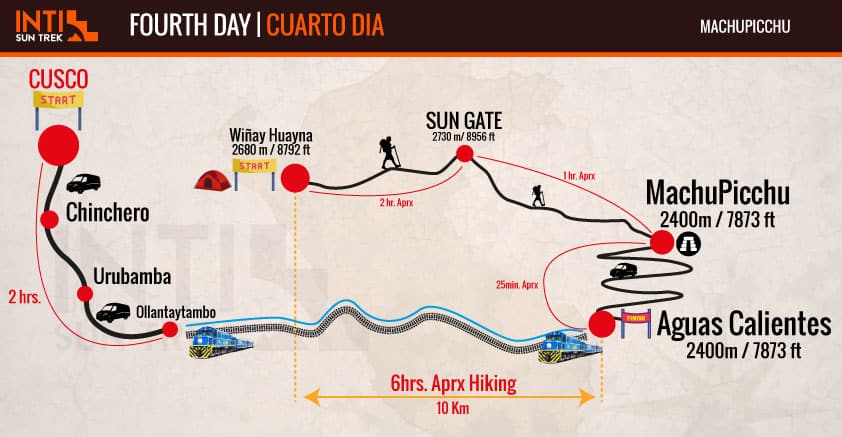
Price
CYBER INCA TRAIL TO MACHU PICCHU!!!
From Only $660 dollars per person.
Important: If you are not used to walking/trekking with a backpack, you should consider booking our 4 Day Inca Trail including a personal porter.
In case we do not meet the minimum group size or we do not have enough people to operate the tour ourselves, we reserve the right to occasionally collaborate with other tour operators. In these cases, the client will always be notified in advance.
Returning train Included in the cost of this tour/trek is the Expedition train, which departs either at 6:20 pm or 7:00 pm DEPENDING ON AVAILABILITY.
Can I get an early train ticket?
We can also book an afternoon train that departs 2:55 p.m. or 4:22 p.m. at an extra cost of US $35 per person the train we will book DEPENDS ON AVAILABILITY.
Please, notice that 35 dollars extra you will pay also will cover your private transportation to bring you back from Ollantaytambo train station to your hotel in Cusco
There is also an option to upgrade your train to the Vistadome train which is the extra US $75 per person. Please let us know your preference at the time of booking the tour. Unfortunately, none of the trains go straight to Cusco—they run either to Ollantaytambo or Poroy. In either case, we will transfer you back by bus to Cusco.
Can I change my return train ticket by myself?
At the time of your tour, it may be possible to make changes to your return train ticket if you don’t want to take the 18:20 p.m train. You will have to take your train ticket personally to the train station in Aguas Calientes and ask them to change the return ticket for an early one. You will probably be asked to pay an extra administration fee, which will depend on the train service and departure time. Please notice that once you will change your returning train you will responsible to cover your own transportation back to Cusco
How long is the journey back to Cusco?
You will be traveling for approximately 3 hours before you arrive back in Cusco. First, you will travel for 1.5 hours by train to the Ollantaytambo train station. Then you will be picked up by your driver outside of the train station. The driver will be holding a sign with your name on it so that there will be no confusion. If you do not see the driver initially, wait for them outside of the train station. Once the driver has picked you up, you will travel for another 1.5 hours in a private van/car to your hotel/hostel in Cusco. Arrival time in Cusco will depend on train availability. You will receive your return train tickets once your guide has finished your walking tour of Machu Picchu.
Important Notice Regarding Student Discounts:
The ISIC card is no longer valid for purchasing Machu Picchu or Inca Trail tickets with a student discount.
Students can still obtain this discount with their student identification card issued by the university where they study, which is the only valid document for this end at this time. For more information, please visit the following link: http://www.machupicchu.gob.pe/items/estudiantes.html
Additional Options
Huayna Picchu
Huayna Picchu is the mountain that stands next to Machu Picchu and can be seen in most photos of the ruins. It is a 45-minute hike to the top. While this hike is done on your own, your guide will direct you to where this hike begins. This requires a separate entrance ticket that we can secure for you with advance notice, for an additional $80 per person.
Machu Picchu Mountain
Machu Picchu Mountain is the other mountain that stands above the Machu Picchu ruins. It offers even more stunning views than Huayna Picchu, but takes an hour and a half of steep climbing to reach the top. This also requires a separate entrance ticket that we can secure for you with advance notice, for an additional $80 per person.
Inclusions
Whats is Included for the Classic Inca Trail to Machu Picchu?
- Pre-departure briefing the night before of your tour in our office.
- Pick-up from your hotel
- A professional tour guide who is fluent in English
- Assistant guide (for groups of 9 or more people)
- Private transportation to the beginning of our trek at Km82
- Inca Trail entrance fees
- Machu Picchu entrance fees
- Two-person tents with plenty of room for your backpacks
- Sleeping mattress
- Meals cooked by an experienced chef: 3 breakfasts, 3 lunches, 3 dinners, and snacks!
- Delicious food rich in carbohydrates and suitable for trekking
- All our food is prepared from organic vegetables and fresh ingredients vegetarian, vegan, gluten, wheat free, or special diets options available
- Water (we will provide you with boiled and filtered cold water during the trek after lunch on the first day. However, you will need to bring a container to carry your water in. Also, you need to ensure that you pack a sufficient amount of water for the first half-day of the trek.
- Porters to carry camping equipment: (tourist tents, dining and cooking tents, table, stools, cooking gear, stove, gas container, cutlery, plates, food, and fresh vegetables).
- Porter’s health insurance paid by INTI SUN TREK PERU
- First aid kit including an emergency oxygen bottle and radios
- Bus ticket from Machu Picchu down to Aguas Calientes
- Expedition train from Aguas Calientes to Ollantaytambo
- Bus transfer from Ollantaytambo train station to your accommodation in Cusco
Whats is not included for the Classic Inca Trail to Machu Picchu?
- Breakfast on the first morning. Some hotels offer an early morning breakfast service. If not, we stop at the town of Ollantaytambo on the way to the start of the trek where you’ll have the chance to buy breakfast.
- Personal porter
- Lunch in Aguas Calientes on the final day.
- Entrance to Huayna Picchu or Machu Picchu Mountain
- Entrance to the thermal springs in Aguas Calientes (optional: 20 soles)
- Sleeping bags (these can be rented from our office for the US $20 for the entire trek. Every sleeping bag is washed prior to each use).
- Tips for the guide, cook, and porters.
- Optional overnight stay in Aguas Calientes (we can change the date of your train ticket if you advise us before paying the deposit).
Packing List
What to Bring:
- Original passport
- Sleeping bag
- A daypack to carry your personal belongings
- Insurance card/certificate
- Hiking boots
- Waterproof jacket or rain poncho
- Warm jacket
- Hat and gloves
- 2-4 t-shirts
- 2 pairs of pants (1 for hiking, 1 for relaxing)
- Long underwear for sleeping/thermal underwear
- Hand sanitizer
- Comfortable trousers
- Sun hat or cap
- Sunscreen
- Personal first aid kit, insect repellent
- Water beginning from your first lunch until your last breakfast will supply all the water needed. This water will be boiled, filtered and then cooled, before distributing. You must supply your own water bottles or Camel Back. We recommend carrying about 2L worth. We will refill our waters at each meal
- We strongly recommend to bring your Camel Back and water canteen due to that government of Peru will not allow disposable plastic bottles anymore on the Inca trail and in Machu Picchu.
- Toiletries/toilet paper
- Personal medication
- Camera and batteries
- Flashlight or headlamp
- Extra money for tips/snacks/beer. (We recommend at least 200-350 extra soles). (US $120)
Optional items to bring:
- Basic first aid kit
- Shorts
- Walking stick
- Sandals
- Bathing suit for hot springs in Aguas Calientes
Before You Go
Pre-Trek Briefing
All briefings are done at our office at 6:00 PM the night before your trek. If you are unable to make this time, you need to coordinate another time with a member of the Inti Sun Trek office team. Briefings are approximately 30 -45 minutes long.
Renewal or change passport number?
If you plan to renew or change your name on your passport between making your trek booking and starting your trek, you can book your trek or tour with your current passport number or name, but you must send us a copy of your old passport and a copy of your new passport when you have them. We can then make the change with the government before you arrive. The extra cost to make the change is US$25 per person. (This will cover the change in number or name for your Inca Trail Permit, Machu Picchu Entrance, and train.)
If you do not advise us of the change or do not want to pay the fee, bring the original of both passports (the old and new one). You can enter Peru with your new passport but you must show the government authorities your old passport in order to enter the Inca Trail, Machu Picchu or train. If you cannot do so, you will not be allowed to start your trek by the government officials. All names and numbers must match!!
Pickups
Inti Sun Trek is one of the only companies to pick you up directly from your hotel. As long as your hotel is in the center of Cusco city,we will coordinate this pickup based on a time that your guide will discuss at the briefing. Pick up times may vary 30 – 45 minutes based on traffic conditions and previous pickups.
Cusco is an old city with cobblestoned streets and very narrow passageways. Very small hotels and Air BNBs are often located on streets that cars can not pass through. They also are often located up on the hillside, with long steep climbs to the property, difficult to maneuver with luggage. We highly recommend that you do not stay at one of these places.
Hiking in the Andes
Is something that everyone can do no matter their age, but it is never easy. You will need some level of fitness to be able to complete it comfortably. Each trial involves inclines that can take your breath away if you are not in shape and downhill hiking that can be tough on one’s knees. Walking sticks are recommended for everyone. Please remember the group treks are open to everyone, all abilities, so be patient and help those struggling with some kind words.
Getting to Cusco
The airport in Cusco is currently only for domestic flights, so all international travelers who arrive by plane must disembark in Lima and go through Customs. Even if your flight to Cusco is the same day by the same airline carrier, you must grab your bags in Lima and then check them back in.
The best way to get to Cusco is by air and there are several options in airlines. LATAM tends to be the most expensive but has the most options and flights.
Expect delays or flight cancellations. Due to the high altitude of Cusco, it tends to be difficult to land and any acclimate weather will stop air traffic. Bus travel is always available and while the trip can be long, especially from Lima, the buses in Peru are very well maintained and comfortable. This option is strongly encouraged if coming from a city closer to Cusco, like Puno. Lima buses will take about 20 hours to arrive.
Storage during your trek to Machu Picchu
Most of our trekkers leave their belongings that they do not want to bring on the trek in the hostel they were previously staying in. These hostels/hotels usually have a secure, locked room where you can securely store your belongings. If you do not trust your hostel, we would be more than happy to store your belongings for you in our office. Make sure your bags have some kind of identification on them so they are easy to locate.
Your Safety is our first concern
Trekking the Andes is not your typical vacation. And most of the people who hike with us have little to no experience with hiking in altitude. We understand the large responsibility we have in ensuring that you are well taken care of every step of the way.
First Aid
Each year, Inti Sun Trek guides receive training in first aid from a physician. We conduct mandatory training every February to which every single guide attends. When guiding you, they will have with them a first aid kit for basic medical problems (traveler’s diarrhea, cuts/scrapes, etc.) and oxygen. They know how to make you feel better. It is important to be very honest with your guide as soon as you are experiencing any discomfort. If you suffer from any medical conditions, please let your guide know during the briefing so he is prepared to give you extra attention, if needed.
In case something unexpected happens and you feel you can no longer complete the trek, they will figure out the safest and quickest way to bring you to a clinic. You will never be left alone and will have a member of the team escorting you during every step until you are safely brought to a doctor. When you are feeling better, we will make sure that you still have the chance to visit Machu Picchu and re-connect with your group, traveling by train comfortably.
Travel Insurance
To protect your travel investment, we highly recommend the purchase of travel insurance. Obtaining travel insurance before you leave home is strongly encouraged and very easy. This is a great way to protect yourself while visiting Peru.
Altitude
Altitude sickness is serious and has the potential to ruin your trip. The biggest mistake you can make is to fly directly to Cusco and expect to hike the next day. Give yourself several days to adjust to the altitude first. You will thank yourself for this during the trek.
The air at high altitudes contains less oxygen than at sea level and forces your body to work harder to get the oxygen it needs. Over several days at high altitude, your body adjusts to the lower amount of oxygen in the air. This is why we always recommend spending at least two days in Cusco before beginning any trek. If you have more time, it is even better. Cusco is an amazing city with a lot to do, so you won’t be bored.
With altitude sickness, you may first feel like you have the flu or a hangover. You may experience a headache, tiredness, loss of appetite, nausea or vomiting, dizziness, trouble sleeping or trouble breathing during exercise. If any of these effects become severe, please contact our office and we will help you get to a doctor. Altitude sickness must be taken seriously.
Most of the time, these symptoms will be mild. We always recommend easing into activity slowly, allowing your body to adjust. Drink plenty of fluids such as water or coca tea. Coca tea has been used since ancient times to help prevent altitude sickness. Leaves from the Coca Plant contain alkaloids, which helps bring oxygen into your blood, helping your body avoid the effects of altitude sickness. Avoid drinking a lot of alcohol and coffee. They will cause you to urinate more often and become dehydrated. Avoid smoking. Smoking makes it more difficult for your body to get oxygen. Avoid sleeping pills. They may cause shallow breathing at night, making it more difficult for your body to absorb oxygen while you sleep.
Your healthcare provider may prescribe medicines, such as acetazolamide and dexamethasone, to help prevent altitude sickness. Start the medicine two days before you get to a high altitude. Continue to take it while you are at high altitude.
You must remember that this is your holiday and you do not want to stress out about the possibility of getting sick from the mountains. Do everything slowly. Drink lots of water. And enjoy the coca tea. If anything does happen and you, unfortunately, get sick, let your guide know right away – all guides are trained in how to help you get through it.
Weather
Of course the weather is unpredictable. Typically the dry season in Cusco is from April through October, but this does not stop rain from falling in June or the Sun from coming out in December – just be prepared. No matter what month you are doing the trek, please make sure that you have rain gear that includes a waterproof jacket, pants, poncho, and waterproof gloves. Many people forget about gloves, but being cold and wet makes hiking very unpleasant. You will notice that there is a large variation between the minimum and maximum temperatures on the trek. In general, when the sun is out it will be very hot. In this heat, you need to drink plenty of fluids to remain hydrated. The early hours of the morning and night can be very cold. As a result, you need to be prepared for just about every weather condition.
What to wear for the trek
One of the most important investments for this trek is a sturdy pair of hiking boots. Your feet will thank you after the long trek if your shoes are well worn in and waterproof. The temperature varies throughout the trek, so it is best to dress in layers. Avoid cotton, as cotton does not dry quickly and wet clothing will be a problem when the temperatures drop pack for four seasons. Many of the treks through the Andes involve many micro-climates and you will need to be prepared for all seasons. A t-shirt, a long sleeve shirt, a sweater/microfleece, and a waterproof jacket. These items will provide you with enough warmth and will allow you to “peel off” layers as it gets warmer or your body temperature increases. Layers are always key as they are easy to adjust to the different temperatures. And evenings will always be cold, so please be prepared with a warm winter-weight jacket.
During the rainy season
Rain pants are a good idea as we will encounter a lot of mud, rivers, and rain. A plastic poncho is also great because it will keep you and your pack dry. You can also pack your belongings inside of plastic bags to ensure that your belongings stay dry.
Do I need to bring hiking boots?
Hiking boots are recommended, as they provide ankle support to reduce the risk of injury, especially when trekking in the wet season (December – March). However, it is important that your boots are comfortable and well worn-in. Many people prefer to trek in tennis shoes but extra care should be taken. We do not recommend trekking in sandals, using new boots, or renting boots prior to the trek. Make sure the shoes are sturdy enough for the duration of the trek and will not fall apart.
Can I use walking sticks on the Inca Trail?
Many people like to hike with trekking poles or walking sticks. This is fine as long as the poles will not cause damage to the stone paving along the Inca Trail. If the trekking poles have metal spikes, then these must be protected by rubber tips. We recommend bringing some spare rubber tips with you. These rubber protectors can be purchased in Cusco or Ollantaytambo. Wooden walking sticks are fine as long as you bring them with you from home.
Recently, government authorities have stopped trekkers from using wooden sticks that could have come from local forests to prevent deforestation of the protected Andean region.
Strikes in Peru
A popular way for the people in Peru to communicate unhappiness with the government is to strike. This area sees quite a few strikes a year that can sometimes affect the logistics involved in our tours. Most strikes are well organized and planned in advance so the office will have at least a few hours to make arrangements if needed.
Changes for logistics: Often this involves leaving for your trek the night before. Please understand we will do everything we can to get you to and from the trail and will give you the information you need as soon as we have it. We will always get you to and from the trail very safely.
Environmental Impact
We use biodegradable soap and transport all our garbage back to Cusco. Our porters are trained to look after the trail and pick up any waste from other groups as well. We also use environmentally-friendly chemical portable toilets that allow us to pack waste out. We believe in leaving no footprint behind.
Equipment provided by Inti Sun Trek
We use only high quality camping equipment for our Peru treks such as Inca Trail, Salkantay trek, Lares Trek and alternative treks!! Inti Sun Trek provides for the treks in Peru, the tent, sleeping bag, dinning tent and toilet tent.Be assured that our equipment is of quality and resistant to all types of land.
We have specialists who choose carefully the tents and implements to be used during your trip to make it an unforgettable and pleasant experience.Below we will show you the characteristics and attributes of our camping equipment. Inti Sun Trek uses the best quality camp team and equipment, complying with the requirements of the specialist in outdoors ensuring in this way the comfort of our travelers according to the requirements of developing our activities in the mountains of the Andes.
Equipment you can rent from Inti Sun Trek
In addition to them, we offer rental items such as sleeping bags, small backpacks, inflatable mattresses, trekking poles, only which can be requested at the time of making your reservation.
These are available for rent from us
Packing List
This Inca Trail Packing List will help you to prepare for your outdoor adventure in one of the most stunning regions of South America.
Luggage for the Inca Trail Trek and Alternative trek is generally divided as follows:
- 1.- Your main suitcase or backpack, can be left in the storage of the of Cusco hotel. most of the tourist generally stay at the same hotel before and after the trek
- 2.- A small daypack that you will use to carry daily essentials such as a jacket, camera, water and sunscreen
We hope that this packing list for Machu Picchu will be useful for any trek you choose and you can do only a few small variations that can suite better for you

